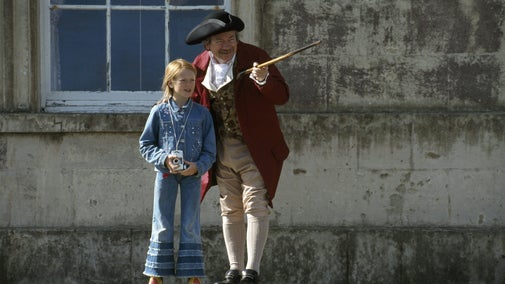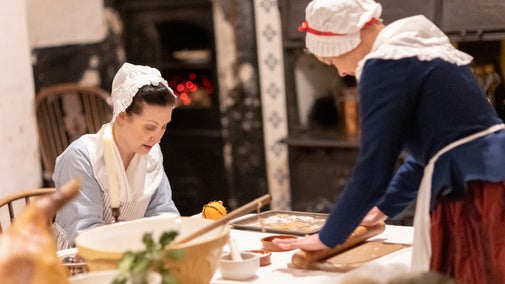
Castle Ward's collections
Explore the objects and works of art we care for at Castle Ward on the National Trust Collections website.

Learn the stories of some of the people connected to Castle Ward over the centuries. From the unconventional life of one of the mansion’s creators, to the conflict-ravaged career of a celebrated war correspondent, the estate’s past residents have fascinating tales to tell.
Although Lady Anne Ward was a co-creator of the dichotomous style of Castle Ward, few of her possessions or papers remain in the collection. Lady Anne left Castle Ward – and her husband Bernard – in 1770, shortly after the house was completed. Since then, she has become the subject of much speculation, and famous for her independent mind and spirit. In May 2024, the National Trust completed a successful acquisition of the only known portrait of Lady Ann, which is on temporary display in the boudoir, before being sent to England for vital restoration and conservation work. This painting is expected to return at some point during the winter.
Lady Anne’s husband Bernard is remembered for the classical side of the house, which has since been taken to represent reason, balance and order. By contrast, Lady Anne’s choice of Gothick architecture was interpreted as conveying her fantastical, whimsical and unconventional personality.
History has found it difficult to understand the architectural decision reached by Lady Anne and Bernard, and it's seen as a metaphor for their failed marriage.
The royal blood from her maternal grandparents gave Lady Anne the hauteur and confidence to do as she pleased. Her grandfather, the Earl of Clarendon, was the nephew of the Duchess of York (the wife of James II), and a first cousin of Queen Anne. Queen Anne was her mother Theodosia’s godmother and, as such, Theodosia was allowed to marry in Westminster Abbey.
This was something Lady Anne was keen to highlight in her choice of architecture at Castle Ward. She even copied the plasterwork from the Henry VII Chapel and recreated it in the Morning Room as a reminder of her royal connections.
Lady Anne’s relationship with a woman, prior to her two marriages, has been the source of much speculation and academic debate.
At 21, Lady Anne embarked on a six-year relationship with Letitia Bushe. Letitia was considered far inferior in status and wealth than Lady Anne, but she was more experienced in the world and had a great intellect.
From the surviving correspondence of Letitia Bushe, it is clear she was besotted with Lady Anne, who was some 15 years her junior.
– Letitia Bushe, writing to Lady Anne in 1740
Academic research has suggested that this instance of same-sex love and desire provided Lady Anne with ‘an alternative outlet for emotional needs and energies, free of the complex web of economic and social considerations that surrounded relations between men and women of the propertied classes’ at this time.
Sadly none of Lady Anne's correspondence to Letitia Bushe survives. In typical Lady Anne fashion she remains an enigma, true to herself regardless of tastes or conventions, and a symbol of ‘the three-dimensional complexity of human life’.

Elizabeth Hastings, Countess of Moira, described Lady Anne’s family as having 'an hereditary malady'. Family members were noted as experiencing varied mental health issues.
Lady Anne was accused of having ‘a shade of derangement in her intellects’. Her brother, Lord Darnley, was convinced he was a teapot and was reluctant to engage in sexual activity lest ‘his spout would come off in the night’. Lady Anne's son Nicholas was declared 'a lunatic’ in 1785 but details about this are scant.
Lady Anne’s grandfather also prompted perception of the family as eccentric. Accounts of the Earl dressing in articles of women’s clothing when carrying out duties as the Colonial Governor of New York challenged social boundaries of the period.
Historians have been unable to confirm the accuracy of these accounts, nor the motivations behind the Earl's alleged presentation of gender non-conformity. Whatever the accuracy or reason, contemporaries condemned the Earl and considered it to be a sign of 'great insanity'.
However, the Earl remained protected and often handsomely rewarded by their cousin Queen Anne. This connection provided crucial protection from critics.
Mary Ward was an accomplished artist, scientist, writer and astronomer who spent time at Castle Ward as the wife of Henry Ward, who would go on to become 5th Viscount Bangor after her tragic death. Her story is one of determination, fascination and creativity.
Born in 1827 in County Offaly, Mary Ward married Henry Ward in 1854. Henry would later become the 5th Viscount Bangor. Mary came into the Ward family already a skilled scientist, author and artist.
During Mary’s lifetime, Castle Ward was not the couple’s main residence but rather acted as a holiday home. Nevertheless, they were frequent visitors to the estate.
In an era when women were not expected to have any scientific ability and were rarely educated beyond the domestic sciences, Mary was a naturalist, astronomer and an early pioneer of the microscope.
She was given a microscope as a gift by her parents as a child, and by 18 she had probably the finest example of a microscope in Ireland. She made her own slides from ivory, and regularly took specimens of insects from Temple Water for her collection.
Mary published books on microscopy and astronomy, helping to popularise the subjects in 19th-century society. She became an advanced astronomer by using the giant telescope built at Birr Castle by her cousin Earl Rosse. Referred to as ‘the leviathan’, it was the largest telescope in the world at the time it was built.
Mary Ward was also a gifted artist, illustrating her own books and painting watercolours on many of her trips, with many scenes of Castle Ward among her collection.
Tragically Mary died after falling from an experimental steam-powered carriage in 1869. It was the first recorded vehicle fatality in Ireland. Following her death, Henry returned many of her treasured possessions to Castle Ward, including her scrapbooks, paintings and her famed microscope. You can see her microscope as part of the estate’s Collection when you visit Castle Ward today.

Described by the Independent as ‘one of the very best of the BBC's war correspondents’, 7th Viscount Edward Ward brought clarity, humour and ingenuity to the new medium of radio reporting.
Born in 1905, Edward spent much of his childhood at Castle Ward before being educated at Harrow and later the Royal Military Academy. Instead of a career in the military he pursued journalism and his early career was spent as a correspondent for Reuters in China.
In November 1939, the BBC sent Edward to report on the Winter War between Finland and the USSR. The world's attention was turning to focus on a growing conflict closer to home but Edward's vivid reports captured the attention of listeners.
He scooped the news of the end of the conflict and was one of the first to bring portable recording equipment to the scene of his reports. Ward’s innovative style of storytelling earned him a role alongside experienced reporters covering the Second World War for the BBC. You can listen to one of Edward’s recordings from an uneasy Paris in 1940.
Destined to be one of the most recognised voices of the Second World War, Edward’s career was dealt a blow when he was captured along with other journalists at Tobruk in 1941. He spent the next three and a half years as a prisoner of war in Italy and Germany before his liberation from Oxflag XII B in March 1945.
– Edward Ward
Upon his release, Ward immediately returned to work. In an extract from his autobiography, Number One Boy, he describes reporting while still in Germany. He worked tirelessly to capture human voices and experiences so they could be saved for the historical record.
After the war he continued to freelance for the BBC and travelled all over the world for his features. In 1950, on the death of his father Maxwell, he became 7th Viscount Bangor and was instrumental in Castle Ward mansion and estate coming into the care of the National Trust.
Edward’s fondness for Castle Ward is clear. Exhausted after his release and immediate return to work at the end of the war, he wished to return to the place where he felt he would be restored again.
– Edward Ward
Edward wrote several books detailing his life as a reporter, his time at Castle Ward and his many travels, some of which are held in the estate’s Collection. Edward Ward died in May 1993 and the title of Lord Bangor passed to his son William.
Nicholas Ward's public image, and the records held about him, were controlled by others.
The story told is that he 'compromised the financial sustainability' of his family who branded him a 'madman' and 'lunatic'.
He was described as rude and unmanageable by his tutor, and the family's actions prevented Nicholas inheriting the full estate and its wealth, as would have been typical for the eldest son.
However, a closer look at the records reveals a more complex story. In his personal letters, he wrote about feeling lonely and his difficulty in learning to speak French.
He was elected as an MP for Bangor in the Irish House of Commons from 1771 to 1775, but in 1785, on the petition of his brother and uncle, he was placed 'under disability' by a bill of the Irish House of Lords.
This tiny silhouette is the only record we have of Nicholas Ward, a trace of a life we know little about.

Explore the objects and works of art we care for at Castle Ward on the National Trust Collections website.

Unique and unusual, this eccentric 18th-century house is famed for having been built with two completely different architectural styles, both inside and out. Find out why.

Wander through the Georgian rooms of this eccentric mansion, famed for its contrasting architecture and interiors, and explore the servants' world below stairs.

Find out about some of the conservation work that staff and volunteers carry out throughout the year to preserve the Castle Ward mansion and estate for everyone, for ever.